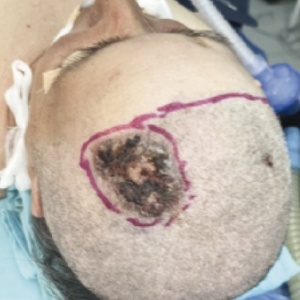Giant basal cell carcinoma of the scalp: rotation advancement flap as a successful dermatosurgical approach

HTML: 12
All claims expressed in this article are solely those of the authors and do not necessarily represent those of their affiliated organizations, or those of the publisher, the editors and the reviewers. Any product that may be evaluated in this article or claim that may be made by its manufacturer is not guaranteed or endorsed by the publisher.
Giant keratinocyte tumors, in particular basal cell carcinomas of the scalp area, are a serious challenge for dermatosurgeons, oncologists, and maxillofacial and reconstructive surgeons. The scalp area is limited in terms of skin mobility, and its elasticity decreases with age. The size of the tumors in this area and the degree of infiltration of the underlying tissues are important for the therapeutic choice, from surgical removal, waiting for granulations to form, and placing a split skin mesh graft (at a later stage) to performing complex rotational/transpositional or advancement flaps. Achieving an optimal aesthetic result is often the consequence of interventions carried out or based on the decisions of multidisciplinary teams. Alternatives, such as radiotherapy and targeted therapy with vismodegib, could be administered both preoperatively and postoperatively or as first-line therapy, depending on the tumor board decisions. We present the case of a 69-year-old female patient with a histopathologically proven preoperative giant basal cell carcinoma of the scalp that did not infiltrate the tabula externa. A preoperative ultrasound was performed to preserve the feeding flap arteries. Surgical treatment under general anesthesia was planned and subsequently carried out. During surgery, the surgical resection lines were in close proximity to the arterial vessels, but they remained preserved and ensured a subsequently unproblematic healing process. After the application of the rotational advancement flap technique under general anesthesia, an optimal cosmetic effect was achieved.
Lozev I, Chernin S, Kandathil LJ, et al. Giant advanced SCC of the scalp with cranial bone invasion: surgical removal and simultaneous defect closure with several rotation advancement flaps. J Eur Acad Dermatol Venereol 2022;36:e791-2.
Kondoff S, Drenchev A, Lotti T, et al. Successful craniotomy for advanced basal cell carcinomas with cranial bone invasion and dura mater infiltration - unique presentation in a Bulgarian patient. Open Access Maced J Med Sci 2018;6:372-5.
Tchernev G, Patterson JW, Lotti T, et al. Multiple primary recurrent basaliomas (mPR-BCCs) of the scalp with cranial bone invasion. Open Access Maced J Med Sci 2017;5. DOI: 10.3889/oamjms.2017.145.
Situm M, Buljan M, Bulat V, et al. The role of UV radiation in the development of basal cell carcinoma. Coll Antropol 2008;32:167-70.
Theotokoglou S, Sgouros D, Theodoropoulos K, et al. Female patient with two simultaneous giants facial basal cell carcinomas demonstrates a positive response to vismodegib as a monotherapy. Indian J Dermatol 2021;66:706.
Tchernev G, Lozev I, Pidakev I, et al. High-risk BCC of the lower eyelid in patient with presternal located cutaneous melanoma and BCC of the shoulder: melolabial advancement flap combined with undermining surgical approach as promising complex one step treatment option! Open Access Maced J Med Sci 2018;6:2147-51.
Tchernev G, Pidakev I. Transposition cutaneous flap and split skin mesh graft as combined optimal treatment approach for giant neglected multicentric BCC of the shoulder. J Eur Acad Dermatol Venereol 2019;33:e12-3.
Archontaki M, Stavrianos SD, Korkolis DP, et al. Giant basal cell carcinoma: clinicopathological analysis of 51 cases and review of the literature. Anticancer Res 2009;29:2655-63.
Betti R, Inselvini E, Moneghini L, Crosti C. Giant basal cell carcinomas: report of four cases and considerations. J Dermatol 1997;24:317-21.
Randle HW, Roenigk RK, Brodland DG. Giant basal cell carcinoma (T3). Who is at risk? Cancer 1993;72:1624-30.
McCarthy JG, Canon PR, Robins P. Malignant tumors of the skin. In: McCarthy JG (ed.). Plastic surgery, Vol. 5. 1st ed. Philadelphia, PA, USA: Saunders; 1990. pp. 3614-62.
LeBoit PE, Burg G, Weedon D, Sarasin A (eds.). Pathology and genetics of skin tumors. WHO classification of tumors, 3rd ed. Lyon, France: IARC Press; 2006. pp. 10-33.
Robinson JK, Dahiya M. Basal cell carcinoma with pulmonary and lymph node metastasis causing death. Arch Dermatol 2003;139:643-8.
Schwartz RA, De Jager RL, Janniger CK, Lambert WC. Giant basal cell carcinoma with metastases and myelophthisic anemia. J Surg Oncol 1986;33:223-6.
Lo JS, Snow SN, Reizner GT, et al. Metastatic basal cell carcinoma: report of twelve cases with a review of the literature. J Am Acad Dermatol 1991;24:715-9.
Rowe DE, Carroll RJ, Day CL Jr. Long-term recurrence rates in previously untreated (primary) basal cell carcinoma: implications for patient follow-up. J Dermatol Surg Oncol 1989;15:315-28.
Copyright (c) 2023 the Author(s)

This work is licensed under a Creative Commons Attribution-NonCommercial 4.0 International License.
PAGEPress has chosen to apply the Creative Commons Attribution NonCommercial 4.0 International License (CC BY-NC 4.0) to all manuscripts to be published.





 https://doi.org/10.4081/dr.2023.9664
https://doi.org/10.4081/dr.2023.9664



